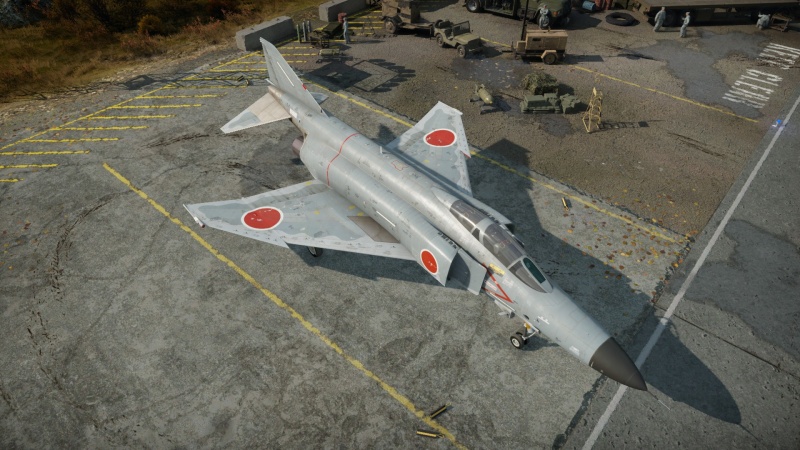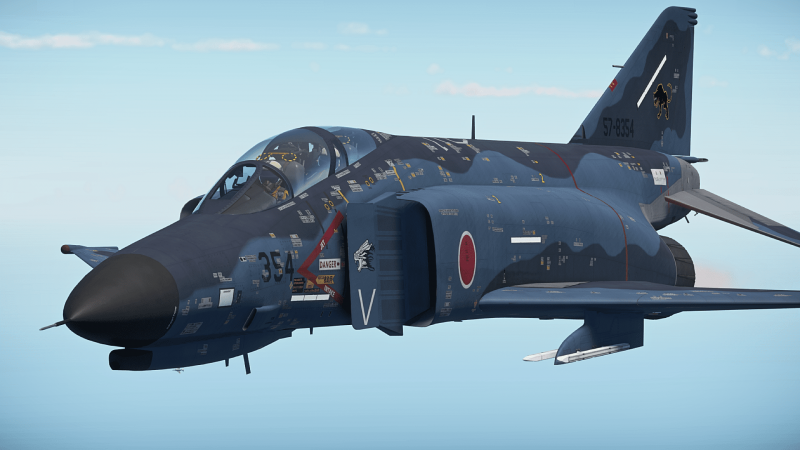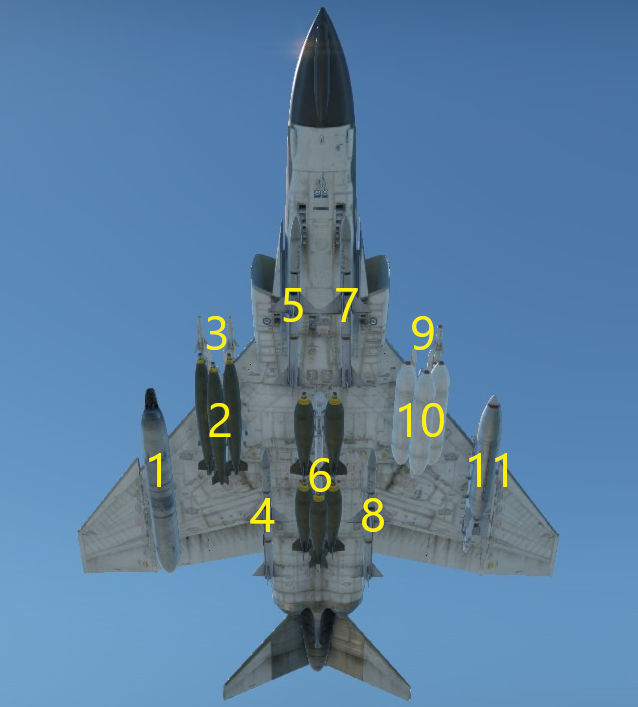Difference between revisions of "F-4EJ Kai Phantom II"
(→See also) (Tag: Visual edit) |
(Tag: Visual edit) |
||
| Line 224: | Line 224: | ||
== History == | == History == | ||
| − | <!-- | + | <!-- F-4EJ "Samurai Phantom" was a jet fighter aircraft that saw service in the JASDF (Japanese Air Self Defense Force) from 1971 until 2020. At the end of 2020, the F-4EJ will be replaced by the F-35A Lightning II. |
| + | |||
| + | In 1968 Japan made it public that they would update their JASDF with the F-4 phantom. Being one of the only countries to acquire the permissions to build the plane in their own Factories, Japan started to develop the F-4EJ at Mitsubishi Heavy Industries. Due to post WW2 sanctions and restrictions, Japan was not allowed to equip any air-to-surface capabilities to the aircraft. As such, the F-4EJ would be made without the AN/AJB-7 bombing computer system. | ||
| + | |||
| + | McDonnell Douglas built the first 2, F-4EJ prototypes with Mitsubishi Heavy Industries building the remaining Phantoms. They did, however, import RF-4EJ from McDonnell Douglas over the 10-year span of production. Mitsubishi Heavy Industries would build the very last F-4 in the world, nicknamed "The Finale Phantom", on the 20th of May, 1981. It served with the 306th and 301st Tactical Fighter Squadrons. 127 EJ variant Phantoms were built. | ||
| + | |||
| + | The first squadron equipped with the new F-4EJ would be the 301st Hikotai, in August 1st 1972. In October 1973, the 301st would be deemed operational with the Phantom, having 14 Phantoms in their squadron. On October 30th 1978, five years after the squadron was equipped and trained in the Phantom: the 301st was designated as JASDF Quick Ready Alert force. In 1979 they would be the first F-4EJ to intercept another aircraft when a Soviet TU-95 was deemed a threat on February 21st of that year. Ironically the same day of the intercept is when Japan launched the Hakucho X-ray satellite & Corsa-B. | ||
| + | |||
| + | In July of 1984, after the post-war sanctions were dropped, Japan put together plans to upgrade its F-4EJ Phantoms. In 1989 their F-4EJ Phantoms were updated starting with the 306th Hikotai. The new Phantoms were equipped with APG-66J pulse-Doppler radar, which allowed the Phantoms to carry out air-to-ground and Air-to-Ship capabilities while being lighter, smaller, and more efficient than the old radar. A new computer and heads up display was added to Phantom, allowing them to bring the Phantom into the 21st century. Additional upgrades to the pylons allowed the new Phantoms to be equipped with the F-15 fuel tanks, which could sustain more G forces than the current fuel tanks being used. And with the adoption of the Westinghouse AN/ALQ-131 countermeasures, it allowed the pilot to adapt and counter any threats on the modern battlefield quickly. These upgrades were desperately needed for the JASDF as their Mitsubishi F-1 and F-2 did not have the range needed to adequately defend their countries territory if war ever arose. 96 Phantoms were upgraded and designated as F-4EJ Kai (Kai means "Modified" in Japanese). | ||
| + | |||
| + | The F-4EJ Phantoms were equipped with 3 different colour schemes. Blue Camo, Green Camo, and Grey. 127 aircraft were built, with 8 squadrons adopting the plane. The F-4EJ was decommissioned in 2020 to adapt to the F-35A Lightning II. | ||
| + | |||
| + | All Japanese phantoms(including RF-4E and RF-4EJ) were retired at 2020-11-20. --> | ||
''Describe the history of the creation and combat usage of the aircraft in more detail than in the introduction. If the historical reference turns out to be too long, take it to a separate article, taking a link to the article about the vehicle and adding a block "/History" (example: <nowiki>https://wiki.warthunder.com/(Vehicle-name)/History</nowiki>) and add a link to it here using the <code>main</code> template. Be sure to reference text and sources by using <code><nowiki><ref></ref></nowiki></code>, as well as adding them at the end of the article with <code><nowiki><references /></nowiki></code>. This section may also include the vehicle's dev blog entry (if applicable) and the in-game encyclopedia description (under <code><nowiki>=== In-game description ===</nowiki></code>, also if applicable).'' | ''Describe the history of the creation and combat usage of the aircraft in more detail than in the introduction. If the historical reference turns out to be too long, take it to a separate article, taking a link to the article about the vehicle and adding a block "/History" (example: <nowiki>https://wiki.warthunder.com/(Vehicle-name)/History</nowiki>) and add a link to it here using the <code>main</code> template. Be sure to reference text and sources by using <code><nowiki><ref></ref></nowiki></code>, as well as adding them at the end of the article with <code><nowiki><references /></nowiki></code>. This section may also include the vehicle's dev blog entry (if applicable) and the in-game encyclopedia description (under <code><nowiki>=== In-game description ===</nowiki></code>, also if applicable).'' | ||
| Line 244: | Line 256: | ||
* [[F-4 Phantom II (Family)]] | * [[F-4 Phantom II (Family)]] | ||
** [[F-4EJ Phantom II]] | ** [[F-4EJ Phantom II]] | ||
| − | |||
;Aircraft of comparable role, configuration and era | ;Aircraft of comparable role, configuration and era | ||
Revision as of 09:15, 12 February 2023
| This page is about the Japanese jet fighter F-4EJ Kai Phantom II. For other versions, see F-4 Phantom II (Family). |
Contents
Description
The F-4EJ Kai Phantom II is a rank VIII Japanese jet fighter with a battle rating of 12.0 (AB) and 12.3 (RB/SB). It was introduced in Update "Direct Hit".
General info
Flight performance
| Characteristics | Max Speed (km/h at 12,192 m) |
Max altitude (metres) |
Turn time (seconds) |
Rate of climb (metres/second) |
Take-off run (metres) | |||
|---|---|---|---|---|---|---|---|---|
| AB | RB | AB | RB | AB | RB | |||
| Stock | 2,255 | 2,221 | 16000 | 26.5 | 27.4 | 141.6 | 131.6 | 850 |
| Upgraded | 2,419 | 2,340 | 25.6 | 26.0 | 204.3 | 172.0 | ||
Details
| Features | |||||
|---|---|---|---|---|---|
| Combat flaps | Take-off flaps | Landing flaps | Air brakes | Arrestor gear | Drogue chute |
| X | ✓ | ✓ | ✓ | ✓ | ✓ |
| Limits | ||||||
|---|---|---|---|---|---|---|
| Wings (km/h) | Gear (km/h) | Flaps (km/h) | Max Static G | |||
| Combat | Take-off | Landing | + | - | ||
| 1458 | 463 | N/A | 580 | 463 | ~11 | ~4 |
| Optimal velocities (km/h) | |||
|---|---|---|---|
| Ailerons | Rudder | Elevators | Radiator |
| < 810 | < 750 | < 700 | N/A |
Engine performance
| Engine | Aircraft mass | |||||
|---|---|---|---|---|---|---|
| Engine name | Number | Basic mass | Wing loading (full fuel) | |||
| General Electric J79-GE-17 | 2 | 13,965 kg | 403 kg/m2 | |||
| Engine characteristics | Mass with fuel (no weapons load) | Max Takeoff Weight | ||||
| Weight (each) | Type | 9m fuel | 20m fuel | 30m fuel | ||
| 1,750 kg | Afterburning axial-flow turbojet | 15,724 kg | 17,787 kg | 19,829 kg | 24,000 kg | |
| Maximum engine thrust @ 0 m (RB/SB) | Thrust to weight ratio @ 0 m (WEP) | |||||
| Condition | 100% | WEP | 9m fuel | 20m fuel | 30m fuel | MTOW |
| Stationary | 5,200 kgf | 8,008 kgf | 1.02 | 0.90 | 0.81 | 0.67 |
| Optimal | 5,200 kgf (0 km/h) |
10,170 kgf (1,400 km/h) |
1.29 | 1.14 | 1.03 | 0.85 |
Survivability and armour
- 8.5 mm of Steel below the cockpit.
Modifications and economy
Armaments
| Ballistic Computer | |||
|---|---|---|---|
| CCIP (Guns) | CCIP (Rockets) | CCIP (Bombs) | CCRP (Bombs) |
| |
|
|
|
Offensive armament
The F-4EJ Kai Phantom II is armed with:
- A choice between two presets:
- 1 x 20 mm JM61A1 cannon, belly-mounted (640 rpg)
- 1 x 20 mm JM61A1 cannon + 90 x countermeasures
Suspended armament
The F-4EJ Kai Phantom II can be outfitted with the following ordnance presets:
- Without load
- 2 x AIM-9P Sidewinder missiles
- 4 x AIM-9P Sidewinder missiles
- 4 x AIM-9L Sidewinder missiles
- 4 x AIM-7E Sparrow missiles
- 4 x AIM-7F Sparrow missiles
- 3 x 20 mm GAU-4 cannons (1,200 rpg = 3,600 total)
- 24 x 500 lb LDGP Mk 82 bombs (12,000 lb total)
- 17 x 750 lb M117 cone 45 bombs (12,750 lb total)
- 285 x FFAR Mighty Mouse rockets
- 60 x Zuni Mk32 Mod 0 ATAP rockets
Custom loadout options
| 1 | 2 | 3 | 4 | 5 | 6 | 7 | 8 | 9 | 10 | 11 | ||
|---|---|---|---|---|---|---|---|---|---|---|---|---|
| 20 mm GAU-4 cannons (1,200 rpg) | 1 | 1 | 1 | |||||||||
| 500 lb LDGP Mk 82 bombs | 6 | 3 | 6 | 3 | 6 | |||||||
| 750 lb M117 cone 45 bombs | 3 | 3 | 5 | 3 | 3 | |||||||
| FFAR Mighty Mouse rockets | 57 | 57 | 57 | 57 | 57 | |||||||
| Zuni Mk32 Mod 0 ATAP rockets | 12 | 12 | 12 | 12 | 12 | |||||||
| AIM-7E Sparrow missiles | 1* | 1* | 1* | 1* | ||||||||
| AIM-7F Sparrow missiles | 1* | 1* | 1* | 1* | ||||||||
| AIM-9L Sidewinder missiles | 2 | 2 | ||||||||||
| AIM-9P Sidewinder missiles | 1, 2 | 1, 2 | ||||||||||
| Maximum permissible loadout weight: 7,257 kg Maximum permissible weight imbalance: 1,500 kg | ||||||||||||
| * AIM-7E and AIM-7F Sparrow missiles cannot be mixed, only one type may be equipped across hardpoints | ||||||||||||
Usage in battles
Describe the tactics of playing in the aircraft, the features of using aircraft in a team and advice on tactics. Refrain from creating a "guide" - do not impose a single point of view, but instead, give the reader food for thought. Examine the most dangerous enemies and give recommendations on fighting them. If necessary, note the specifics of the game in different modes (AB, RB, SB).
Pros and cons
Pros:
- Eased up modifications over the F-4EJ
- Comes with 2 x AIM-9Ps stock instead of 2 x AIM-9Bs
- 4 x AIM-9Ps is a tier I mod without the need of AIM-9Es
- A wide range of suspended armaments, suitable for any playstyle
- Powerful AIM-7F SARH missiles
- Top-of-the-line AIM-9L missiles, having excellent manoeuvrability of 30G, long range, great all-aspect tracking, and being somewhat flare resistant
- Deadly frontal armament with high burst mass
- Makes use of a ballistic computer for assisting in the aim of cannons, rockets, and bombs against ground targets
- Large reserve of countermeasures
- AN/APG-66 radar - has diverse scan and tracking modes, very high resistance to notching and chaff, very long range
Cons:
- Limited ammunition in the frontally-mounted cannon
- Terrible manoeuvrability along with mediocre acceleration and top speed, particularly compared to common opponents
- Doesn't have an Agile Eagle package like the F-4E and F-4F to increase manoeuvrability
History
Describe the history of the creation and combat usage of the aircraft in more detail than in the introduction. If the historical reference turns out to be too long, take it to a separate article, taking a link to the article about the vehicle and adding a block "/History" (example: https://wiki.warthunder.com/(Vehicle-name)/History) and add a link to it here using the main template. Be sure to reference text and sources by using <ref></ref>, as well as adding them at the end of the article with <references />. This section may also include the vehicle's dev blog entry (if applicable) and the in-game encyclopedia description (under === In-game description ===, also if applicable).
Media
- Skins
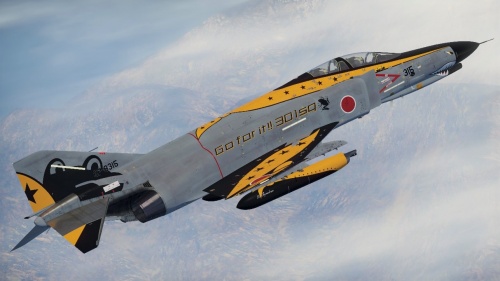
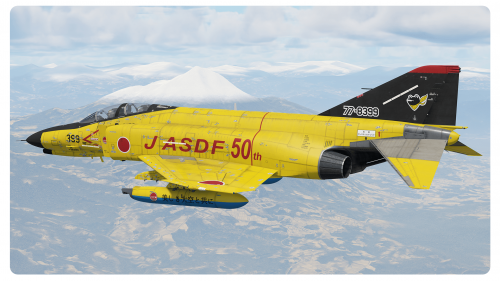
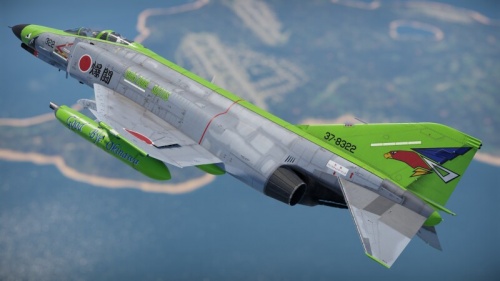
See also
- Related development
- Aircraft of comparable role, configuration and era
- Mikoyan-Gurevich MiG-21 (Family)
- SAAB J35D Draken
- Dassault Mirage IIIC
External links
| Japan jet aircraft | |
|---|---|
| IJNAS | |
| Experimental | Kikka |
| Reconnaissance | R2Y2 Kai V1 · R2Y2 Kai V2 · R2Y2 Kai V3 |
| IJAAS | |
| Fighters | Ki-200 |
| JASDF | |
| Fighters | F-86F-30 ▅ · F-86F-40 ▅ · F-86F-40 JASDF▅ |
| F-104J | |
| F-4EJ Phantom II · F-4EJ ADTW · F-4EJ Kai Phantom II | |
| F-15J · F-15J(M) | |
| F-16AJ | |
| F-1 | |
| Trainers | T-2 Early · T-2 |
| Foreign | |
| Thailand | ▄AV-8S · ▄F-5E FCU |



